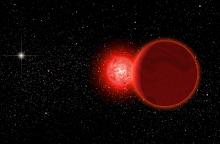Listen to today's episode of StarDate on the web the same day it airs in high-quality streaming audio without any extra ads or announcements. Choose a $8 one-month pass, or listen every day for a year for just $30.
You are here
Vindemiatrix
Vindemiatrix, the third-brightest star of Virgo, is in the southwest at nightfall. It’s far to the upper right of Spica, Virgo’s brightest star.
Vindemiatrix is a giant -- a bloated star that’s completed the “normal” portion of its life. It’s more than 10 times the diameter of the Sun. It’s almost three times heavier than the Sun, and almost 80 times brighter.
Astronomers know these details because they know the star’s distance -- more than 100 light-years. Without the distance, we can’t know a star’s true brightness, which is one of the keys to learning its full story.
Measuring a star’s distance isn’t easy, though. For most stars, astronomers use a technique called parallax. They measure the star’s position when Earth is on opposite sides of the Sun. That’s like holding a finger out at arm’s length and looking at it with one eye, then the other -- the finger appears to move a bit compared to the background. And the same thing happens with a star -- it appears to shift back and forth a bit compared to the stars around it.
The angles are tiny, so they’re tough to measure. That’s especially true from the ground, because the atmosphere makes a star look like a fuzzy blob.
The best measurements come from spacecraft. Gaia, a European craft, has measured the parallaxes of more than a billion stars. Its work shows that Vindemiatrix is 106 and two-thirds light-years away -- what should be the best measurement ever of the distance to this bloated star.





